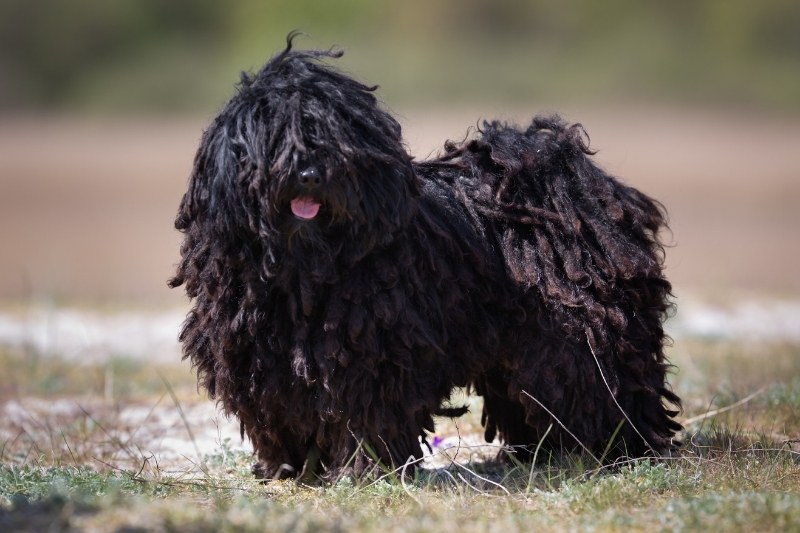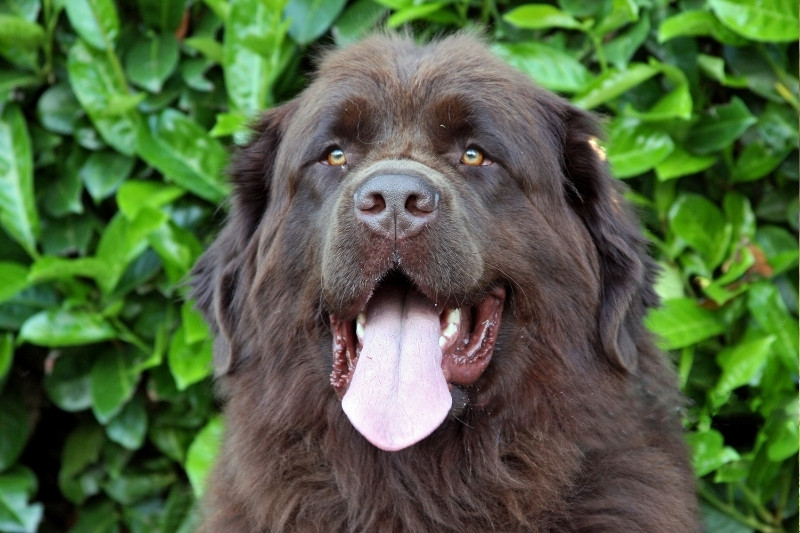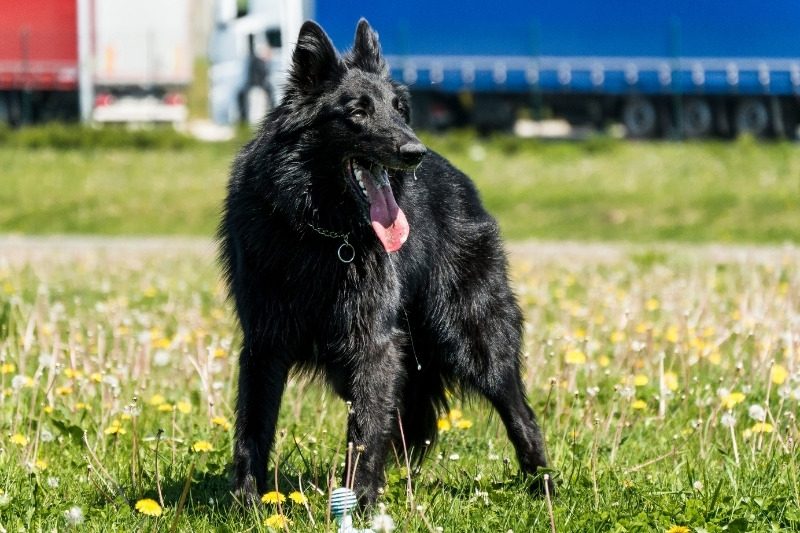6 dogs with dreads (with pictures!)

There are lots of different kinds of coats when it comes to our canine friends. Some have thick double coats, some curly coats, and others are completely bald. But did you know there are a couple of dog breeds with dreads? They come in all different shapes and sizes and all of them have an adorable, mop-like coat.
Although often referred to as dreadlock dogs, the actual terms for this type of coat are cords, flocks, and mats.
So, why does my dog get dreadlocks?
There are only six dog breeds that have dreads. Three of them have them naturally (Puli, Komondor, and Bergamasco Sheepdog) whilst others achieve the look after a little TLC at the dog groomers or at home (like the Poodle, Spanish Water Dog, and Havanese).
The reason why some dog breeds naturally have dreadlocks is that their outer coat twists with their undercoat. These breeds have a soft, down-like undercoat and a coarse and wavy outer coat which rubs and twists together to create the iconic corded coat.
Can you give dogs dreadlocks?
Dogs such as Poodles have the right kind of hair texture to create cords but they need a helping hand from humans. You'll need to separate and twist their curly coat into cords to create the look.
Nowadays, this isn't a particularly popular look for breeds such as Poodles because it's just so time-consuming and labor-intensive.
When it happens, though, it's very striking – especially when it's paired with the traditional poodle haircut!
6 dogs with dreads
So, we know that some pups have naturally occurring dreads and that others have the right coat type for them to be twisted for the look. Let's take a closer look at each of the 6 dog breeds.
Puli

Puli dogs are probably the most famous breed to have dreadlocks. They have a double coat and the difference in texture makes the long outer coat combine with the softer undercoat. The cords themselves are quite wooly and can be flat or round.
Puli puppies start to form cords and these grow longer as the puppy matures. Although similar in look to the Komondor breed, you need to take extra care that a Puli's cords don't tangle together. This traps dirt and oil and doesn't allow the skin to breathe which can cause irritation and infection.
Furthermore, these dogs can grow dreads in their ears, which can become infected, so always keep an eye out!
Although one of the most famous breeds with dreadlocks, the American Kennel Club actually accepts Pulis with dreads or a brushed-out coat. It's a big commitment if you decide to brush your Puli's coat as it will naturally want to tangle.
Pulis are native to Hungary and were originally bred to work. If you're after an exceptional herding dog, a Puli might be a good option. They're hard-working, alert, intelligent, and affectionate towards their family members.
Their long coats suit their outdoor lifestyle but don't be fooled – Pulis are just as happy curled up snoozing in front of the fire.
Komondor

Komondors look a lot like Pulis in that they have a long, naturally occurring, dreaded coat. The dreads of this dog breed, however, are usually thicker than that of a Puli. Komondor puppies tend to grow a curly, fluffy coat first, which then turns into curly cords. These initial cords are short and grow close to the skin.
As the dog grows older, the dreads grow longer and fuller. In fact, it's so important that Komondors have dreads that if they don't have them by the time they're two they'll be disqualified from competition!
These pooches are really popular in their native Hungary. They were first brought there by the Cuman tribe (hence their name ‘dog of the Cumans') and were also used to herd and guard cattle and sheep.
Their long, white coats helped them to mix in with the flock and camouflage against the snow. This breed's coat texture kept them warm in the fields and protected them from predators.
Komondors are intelligent and calm dogs that are happy working and spending time with their family. Their endearing and curious natures make them great family dogs too.
Bergamasco Sheepdog

The Bergamasco Sheepdog is a relatively new addition to the list of dogs with dreads – well, according to the American Kennel Club at least. Although they were only accepted in 2015, these adorable pups have been around for thousands of years.
Not only are they an old dog breed but there's something else pretty special about these doggos – they have three coats! The undercoat is soft and oily, the second wirier, and the third has a wooly texture. Their three coats and curly locks are the perfect combination to form a dreaded top coat.
Rather than cords like the Komondor and Puli coat, these dogs tend to form larger, flat mats. These can be a couple of inches thick and come in many different shades of brown and gray. It's common for Bergamasco Sheepdogs to have mats that are different colors, giving them a wonderfully unique coat.
This Italian dog is sociable, yet also independent. They're happy to work in the fields and also spend time playing and cuddling with their family. Bergamascos are intelligent dogs and love to keep their brains active through working or learning new tricks.
Havanese

Havanese dogs are smaller than others on the list but they're adorable pups that make wonderful family pets.
Unlike the first three, these pups don't always have a dreaded coat. It can, however, be done (with a lot of effort from dog owners)! Their fur grows very quickly which means owners need to separate the sections of hair to cord them. It's important you check their coat regularly and carefully to see whether any mats are forming.
These pups were first bred in the 1800s as beloved pets of the Cuban aristocracy. They grow really strong bonds with their human friends (in fact, they're often named the velcro dog) and love to be the center of attention in any family.
These dogs are playful, intelligent, curious, and can work as assistant dogs too. Because they're so loving and form such bonds with their owners, they can easily suffer from separation anxiety and shouldn't be left for hours at a time.
Havanese dogs get on well with children and other animals and will love to have a playmate to spend their days with.
Poodle
When it comes to dogs with dreads, not many of us think about Poodles straight away. These doggos are known for their iconic curly coats and haircuts. But it's possible for them to have dreads (or mats) too!
Unlike other pups with dreadlocks, Poodles only have one coat of fluffy curls. They don't naturally mat but rather owners need to dread them themselves. As the dogs shed hair, it gets caught in the mats and causes them to grow in size. But this is not easy.
Giving your Poodle pup dreads is a meticulous task – which is why it isn't a popular hairstyle anymore. Poodles come in many different sizes and colors and all can have this unusual appearance. But it takes human intervention.
Poodles are incredibly intelligent dogs and love to learn lots of new tricks. They can be a little stubborn (and think they know best) so need an experienced owner who can manage that. These pooches are very energetic and need a lot of daily exercise. They love to play, run, and chase after anything.
Although not very popular nowadays, Poodles with dreads are seriously attractive pups. This is especially true when it's combined with their iconic haircut!
Spanish Water Dog

Just like Poodles, Spanish Water Dogs only have one coat. An adult dog may have naturally forming mats or you may have to help them along the way if that's the desired look you're after. Some say it's best to shave them first and then let their hair grow out as you twist and shape it into dreads.
Spanish Water Dogs don't just have dreads because they look good. Their corded look actually helps them to do their job.
These pups were first bred as herders and water dogs meaning they've spent most of their days helping farmers and fishermen alike. Their heavily matted coat provides a waterproof layer which helps protect their organs and keep them warm and dry whilst they're jumping in and out of water.
This Spanish breed is exceptionally loyal and loves to spend time with its owner. They enjoy hunting, outdoor activities, and spending time relaxing at home. Like Poodles, they can be a bit stubborn so they need a confident owner who can show them the ropes.
Caring for your dog's dreads
Getting a dog with this distinctive hairstyle does come with some added responsibility for owners. You need to make sure you care for the dreads so they don't become one large and painful mat. To be honest, you're probably going to want to find a good groomer close by.
Cleaning dreads
It's important to clean dreads to keep them healthy and stink-free. Not only can oil build up, but dirt, debris, and other things can get trapped in the dreads too.
You can't, however, just lather up a pup with dreads as you can other breeds. Each individual dread needs to be soaked in soapy water and then thoroughly dried. It's probably best to do this at a professional groomer as they should have a drying machine that can help stop odors from developing.
Brushing dreads
In general, you shouldn't brush your dog's dreads. This will be painful and unnecessary. You might, however, have to gently pull cords apart to stop them from matting. If you have a corded pup and want to change their appearance (for example with a Poodle) talk to your groomer about your options and the best way to do it.
If you have a Havanese and you don't want them to grow a matted coat, it's crucial you monitor their coat and brush out any mats as they start to form.
Trimming dreads
Again, this really depends on your dog's breed and unique coat. Some dogs won't need to have their dreads trimmed, others will have to stop them from dragging on the floor and collecting dirt. It's also worth trimming your dog's dreads if they're preventing them from eating or seeing.
Some dogs can grow dreads in their ears and around their eyes. These can cause infections so it's important you trim them and keep them clean. Talk to your groomer if you're not sure.
Whether you're a fan of the dreaded look or not, you can't deny these dogs are striking. They also make wonderful family pets for owners willing to give them the attention, exercise, and mental stimulation they require. Would you consider getting a dog with dreads?
I’m Charlotte, a content and copywriter from the North of England and currently living in Berlin. Animals have always been a huge part of my life, so writing about dogs is a total pleasure! I love all kinds of dogs and their cheeky personalities, but I’d have to say Weimaraners are my favourite!







